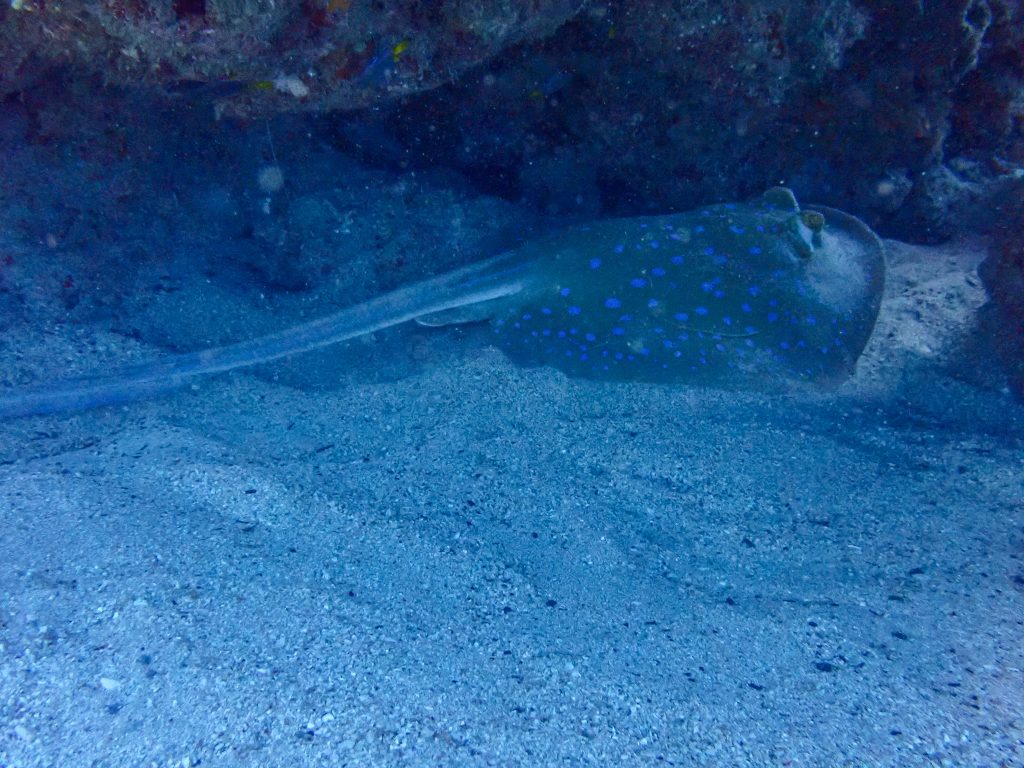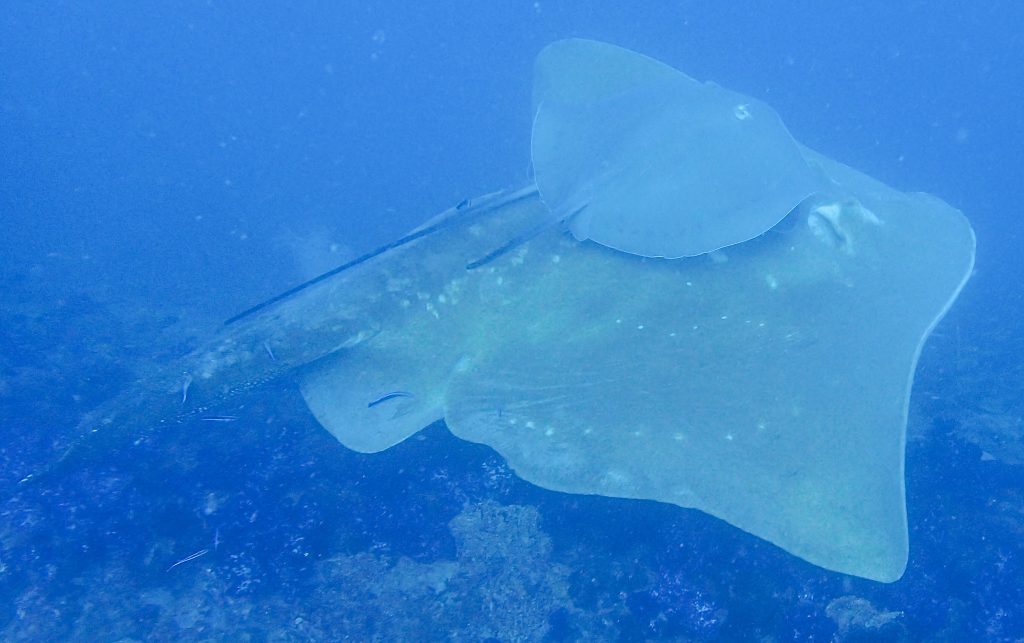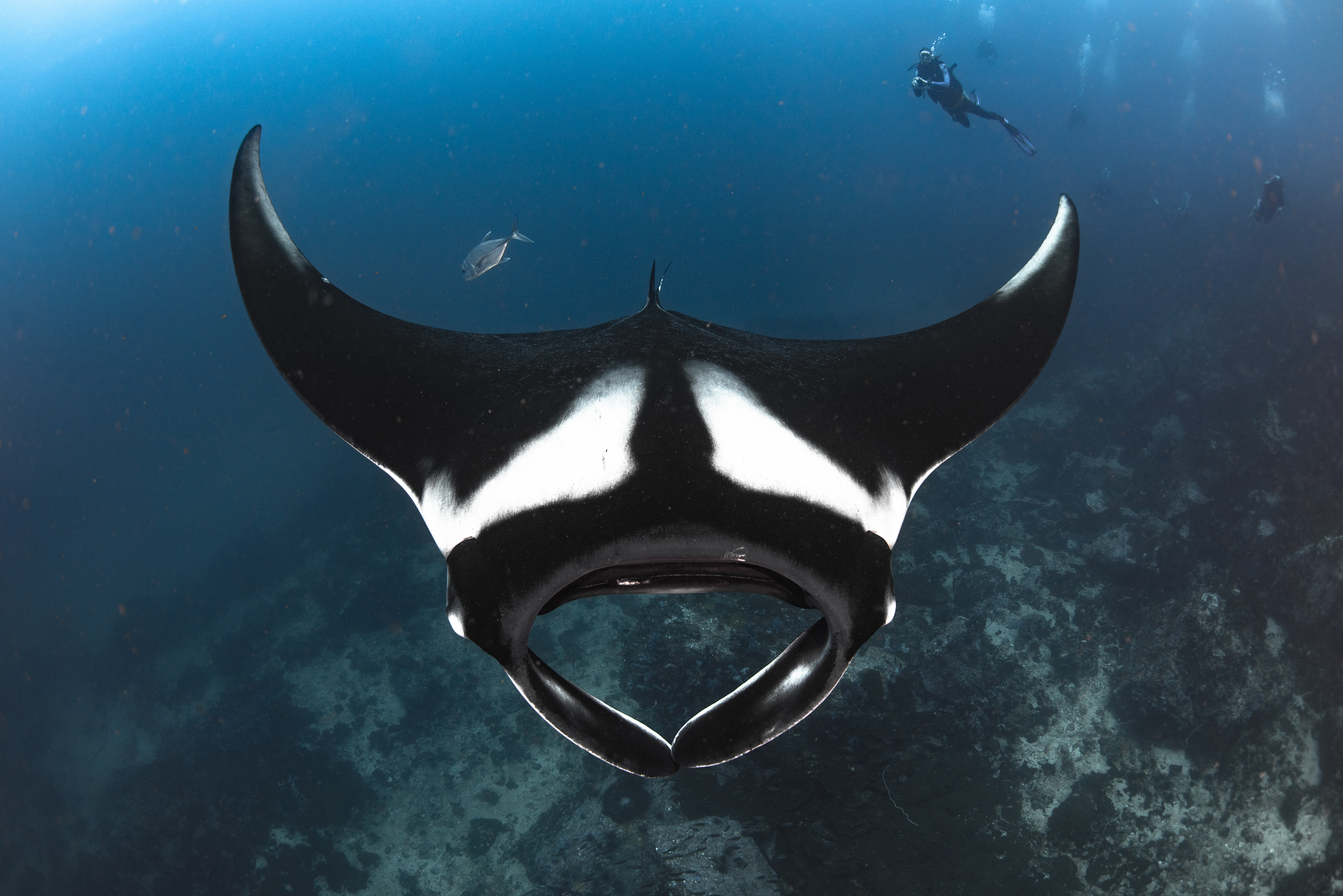I was diving at Wreck Beach Reef, Great Keppel Island, last Friday and I managed to photograph a Blue Spotted Fan Ray (Taeniura lyenma) –a regular stingray in the family Dasyatidae except with blue spots!
It was my dive buddy Kirsty who spotted it while peering under one of the large boulder corals (the Porites spp.) that are scattered around the perimeter of this reef. There are usually painted sweetlips (Diagramma pictum) on guard, that move only when you swim right up to them. I managed to get my camera and myself underneath one of the boulder corals and then inside what turned out to be a reasonable sized cavity. It was quite an effort, for a very ordinary photograph of a common ray.

I am an amateur photographer. It is a memory – and a research grade observation now lodged at iNaturalist.
Blue Spotted Fan Rays are magnificent creatures, but not megafauna. They are small in the scheme of things, as far as rays go.

I have photographed a mega ray, specifically a Smalleye stingray, scientific name Megatrygon microps.
That was at sunrise at the SS Yongala wreck dive site on May 6th this year. It was the most magical encounter, as the Mega-trygon circled with three whiptail stingrays slipping and sliding on-top. I have described how curious the stingray was in a blog post, CLICK HERE.


We are planning to dive the Yongala wreck – arguably one of the best ten dive sites in the world – as part of the Underwater Megafauna Photographic Competition and Expedition, departing Townsville Breakwater Marina on Monday 2nd September. This photographic competition has a category ‘largest ray, shark or whale’ and ‘largest fish that is not a ray or shark’.
There can be all of these at the Yongala!
I’ve received some fabulous applications from some talented underwater photographers.
Three of the five spots have already been awarded. I will be letting the final two successful megafauna photographers know next Tuesday – that will then make five departing on the MV Sea Esta for four days and five nights, potentially 14 dives in total, with the last two dives at the Yongala, weather permitting.
It’s not too late if you want to apply. But you need to get your application in before 5pm on Monday, July 29th.
Of course, the biggest rays are the Manta Rays (family Myliobatidae, subfamily Mobulinae) that can reach over 6 metres across. That is mega!
There are about 37 species in this family, with their eyes on the side of their head, which is not fattened. I’ve scuba dived with Manta Rays at Lady Elliott Island, and at Shark Alley off Stradbroke Island. I’m hoping that they will be at the Yongala for the Megafauna Expedition.
David Strain describes his experience with a Manta at the Yonga at the PADI blog:
As Manta Rays sat over the wreck in 15 metres of water facing into the strong current, gills open as an invitation to the resident cleaner wrasse before turning down current, gliding away then around to again take up position over the wreck.
At times they would pass so closely that the downdraft from their wings could be felt only inches from my face. On occasions the manta would position itself directly above as if enjoying the bubble massage from my regulator.
In 10 dives over 4 days I have experienced the changing moods, colours, light and amazing marine life of this truly awe inspiring place on earth.
The Yongala.
More information about the expedition and selection criteria for photographers, CLICK HERE.
There is something more interactive at my official Facebook page, especially if you click on the ‘megafauna expedition’ that is pinned as an event at the top, LINK HERE.


 Jennifer Marohasy BSc PhD is a critical thinker with expertise in the scientific method.
Jennifer Marohasy BSc PhD is a critical thinker with expertise in the scientific method.

Love your work Jennifer.
Jennifer Marohasy wrote: (not in this posting)
What is real, is natural climate change that is part of a natural cycle within a cycle, within a cycle and the arc of the moral universe demands that we begin with this truth whichever side of politics.
Natural Climate Change is not properly studied, not understood and not considered honestly.
“Natural Climate Change is not properly studied, not understood and not considered honestly” I couldn’t agree more.
The current climate change narrative began with the precept that humankind was responsible for it. Once the early alarmists got traction and the money started to flow there was no stopping the boondoggle but I have a sense that things are changing.
The advent of ugly windmills has caught the attention of even the true believers. When the veil is lifted so called renewable and sustainable solutions are worse polluters than anything that went before, including coal fire power stations.
@Petert McRae, you should look at the money flow from the fossil fuel industry to climate change denial. It is simply a repeat of the tobacco industry denying the health catastrophe that smoking caused. In fact, pro-tobacco publicists are now working for right wing think tanks like the IPA.
@Karen Klemp. Twenty years ago I was labelled a climate change denier by people who should have known better. I took it as a badge of honour back then and still do. If all you have is nonsensical statements like money flowing from fossil fuel industry to climate change denial then it’s back to the drawing board for you.
@Peter McRae, it seems you have learned little in the last 20 years. And probably the 10 years before that.
I never tire of rays. Though I now rely on Jennifer’s photos to bring back many memories of encountering them and notably when hidden under the sand on the reef talus and only their eyes were poking out. In cloudy water and/or murkier depths devoid of much light one had to be careful not to disturb them by mistake and risk a sharp and painful welcome. For those wondering, there are many fascinating creatures to see in the sand and one has to get close up for photography – Mantis shrimps, gobies and many others in burrows, solitary single polyp disc corals etc., – so a surprise encounter with a buried ray is not unusual.
Thanks Jenn.
Never having more than my toes in salt water, I appreciate you.